Study on the Early Effect of Excitation Method on the Alkaline Steel Slag
Abstract
:1. Introduction
2. Materials and Methods
2.1. Materials
2.2. Test Design and Specimen Preparation
2.3. Methodology
3. Results and Discussion
3.1. Effect of Mechanical Excitation on the Particle Size of Steel Slag
3.2. Effect of Mechanical Excitation on the Activity of Steel Slag
3.2.1. Compressive Strength
3.2.2. Flexural Strength
3.3. Effect of Salt Excitation on the Activity of Steel Slag
3.3.1. Compressive Strength
3.3.2. Flexural Strength
3.4. Effect of Alkaline Excitation on the Activity of Steel Slag
3.4.1. Compressive Strength
3.4.2. Flexural Strength
3.5. X-ray Diffraction Analysis of Steel Slag Substitute Cement
3.6. Microstructure Analysis of Steel Slag Substitute Cement
4. Conclusions
- (1)
- Through the mechanical grinding experiment, the particle size distribution curve of steel slag gradually shifted to the left. After grinding for 40 min, D50 decreased by 72.9%, and D90 by 85.4%. The change range of coarse particles in steel slag was larger than that of fine particles, and it was more difficult for fine particles to be further refined.
- (2)
- Mechanical excitation can significantly improve the activity of steel slag. After grinding for 10 min, the 3d compressive strength can reach 19.29 MPa, and the 7d compressive strength can reach 23.32 MPa. The comprehensive excitation effect, economic cost, the optimal grinding time is 20 min, and the content of steel slag is 10%.
- (3)
- Salt excitation can further enhance the activity of steel slag based on mechanical excitation. The optimal excitation content is 2.0%, and steel slag content is 20%.
- (4)
- Alkali excitation can further enhance the activity of steel slag based on salt excitation and mechanical excitation. The optimal excitation content is 1.0%, and steel slag content is 25%.
- (5)
- The hydration products replaced by steel slag are mainly calcite (CaCO3), calcareous hydroxide (Ca(OH)2), and dicalcium silicate (Ca2SiO4). With the increase of curing age, the hydration products become coarser and interwoven, forming a fibrous network structure, which further enhances the mechanical properties.
Author Contributions
Funding
Institutional Review Board Statement
Informed Consent Statement
Data Availability Statement
Conflicts of Interest
References
- He, Z.H.; Zhang, X.X.; Zhan, P.M.; Yang, Y.F. Research Progress of Steel Slag Powder and Its Effect on the Properties of Cement-Based Materials. Concrete 2020, 2, 83–89, 93. (In Chinese) [Google Scholar]
- Dong, Q.; Wang, G.; Chen, X.; Tan, J.; Gu, X. Recycling of steel slag aggregate in portland cement concrete: An overview. J. Clean. Prod. 2020, 282, 124447. [Google Scholar] [CrossRef]
- Li, J.S.; Li, J.M.; Ge, X.X. Preparation and Characterization of Early Strengthened of Binding Materials Steel Slag & Blast Furnace Slag. J. Anhui Univ. Technol. Nat. Sci. 2020, 37, 321–326. (In Chinese) [Google Scholar]
- Singh, S.; Jyoti; Vashistha, P. Development of newer composite cement through mechano-chemical activation of steel slag. Constr. Build. Mater. 2020, 268, 121147. [Google Scholar] [CrossRef]
- Wang, H.G.; Peng, B.; Yue, C.S.; Bai, Z.T.; Zhang, M.; Guo, M. Research Progress and Prospect of Steel Slag Modification. Environ. Eng. 2020, 38, 106, 133–137. (In Chinese) [Google Scholar] [CrossRef]
- Zhao, J.H. Grinding and Hydration Characteristics of Steel Slag and Composition and Properties of Composite Cemitious Materials Containing Steel Slag Powder. Ph.D. Thesis, University of Mining & Technology, Beijing, China, 2015. (In Chinese). [Google Scholar]
- Cui, X.W. Research of High-Performance Concrete Prepared with the Steel Industry Solid Waste as Raw Materials; University of Science & Technology Beijing: Beijing, China, 2017; pp. 7–10. (In Chinese) [Google Scholar]
- Jiang, L. Oxidation Modification of Steelmaking Slag and the Composition, Structure and Property of Modified Slag; China Building Materials Academy: Beijing, China, 2018; pp. 10–13. (In Chinese) [Google Scholar]
- Wel, L.; Li, H.; Zhang, J. Mechanism and Recent Development of Steel Slag Activating Activity. Mater. Rep. A 2014, 28, 105–108, 128. [Google Scholar] [CrossRef]
- You, N.; Li, B.; Cao, R.; Shi, J.; Chen, C.; Zhang, Y. The influence of steel slag and ferronickel slag on the properties of alkali-activated slag mortar. Constr. Build. Mater. 2019, 227, 116614. [Google Scholar] [CrossRef]
- Min, Z.A. Study on the Effect of Hydration of MgO in Steel Slag and the Effect of Hot Tantalum on the Hydration Characteristics of Steel Slag. Master’s Thesis, Beijing University of Chemical Technology, Beijing, China, 2018. (In Chinese). [Google Scholar]
- Guo, J.; Bao, Y.; Wang, M. Steel Slag in China: Treatment, Recycling, and Management. Waste Manag. 2018, 78, 318–330. [Google Scholar] [CrossRef]
- Liu, M.C. Research and Application of Back filling Cementing Material for Mine Industry; Hebei University of Science and Technology: Shijiazhuang, China, 2018; pp. 18–19. (In Chinese) [Google Scholar]
- Jiang, L.; Wu, T.; Ma, L.F. Research on Grindability of Modified BOF Slag. Bull. Chin. Ceram. Soc. 2018, 37, 4034–4039. (In Chinese) [Google Scholar] [CrossRef]
- Dong, P.X. Research on Cementitious Materials and Rheological Properties of the Whole Tailings in Angang Iron. Ph.D. Thesis, University of Science & Technology Beijing, Beijing, China, 2018; pp. 54–57. (In Chinese). [Google Scholar]
- Li, Z.X.; Dai, S.B.; Ma, B.G.; Liu, F.L.; Zhou, X.T.; Zhang, T. Effect of Steel Slag-Fly Ash-Silica Fume Composite Modifier on Properties of Sulphoaluminate Cement. Bull. Chin. Ceram. Soc. 2020, 39, 175–181. (In Chinese) [Google Scholar] [CrossRef]
- Xiao, B.; Wen, Z.; Miao, S.; Gao, Q. Utilization of steel slag for cemented tailings backfill: Hydration, strength, pore structure, and cost analysis. Case Stud. Constr. Mater. 2021, 15, e00621. [Google Scholar] [CrossRef]
- Zhang, H.; Wang, L.; Long, H.M. Effect of Alkali-activator on Compressive Strength of Steel Slag Cementations Materials. Chin. J. Process Eng. 2018, 18, 382–386. (In Chinese) [Google Scholar] [CrossRef]
- Liu, X.; Cui, X.W.; Ni, W. Influence of Steel Slag Powder on Strength of Concrete With Industrial Solid Wastes. Met. Mine 2016, 10, 189–192. (In Chinese) [Google Scholar]
- Xiang, X.-D.; Xi, J.-C.; Li, C.-H.; Jiang, X.-W. Preparation and application of the cement-free steel slag cementitious material. Constr. Build. Mater. 2016, 114, 874–879. [Google Scholar] [CrossRef]
- Gao, T.M.; Dai, T.; Shen, L.; Jiang, L. Benefits of Using Steel Slag in Cement Clinker Production for Environmental Conservation and Economic Revenue Generation. J. Clean. Prod. 2021, 282, 124538. [Google Scholar] [CrossRef]
- Sun, Y.H.; Chen, M.Z.; Chen, D.Y.; Liu, S.; Zhang, X.; Wu, S. Laboratory Preparation and Performance Characterization of Steel Slag Ultrafine Powder Used in Cement-Based Materials. Sustainability 2022, 14, 14951. [Google Scholar] [CrossRef]
- Zhuo, K.-X.; Liu, G.-T.; Lan, X.-W.; Zheng, D.-P.; Wu, S.-Q.; Wu, P.-Z.; Guo, Y.-C.; Lin, J.-X. Fracture Behavior of Steel Slag Powder-Cement-Based Concrete with Different Steel-Slag-Powder Replacement Ratios. Materials 2022, 15, 2243. [Google Scholar] [CrossRef]
- Sun, X.; Liu, J.; Zhao, Y.; Zhao, J.; Li, Z.; Sun, Y.; Qiu, J.; Zheng, P. Mechanical activation of steel slag to prepare supplementary cementitious materials: A comparative research based on the particle size distribution, hydration, toxicity assessment and carbon dioxide emission. J. Build. Eng. 2022, 60, 105200. [Google Scholar] [CrossRef]
- Zhu, H.J.; Ma, M.Y.; He, X.Y.; Zheng, Z.; Su, Y.; Yang, J.; Zhao, H. Effect of wet-grinding steel slag on the properties of Portland cement: An activated method and rheology analysis. Constr. Build. Mater. 2021, 286, 122823. [Google Scholar] [CrossRef]
- Zhao, T.; Chen, T.J.; Chen, Y.L.; Pan, L.T.; Huang, X.Z.; Chen, X. Effects of Mechanical Activation and Stainless Steel Slag Content on Properties of Slag Cementitious Materials. Bull. Chin. Ceram. Soc. 2022, 41, 553–561. (In Chinese) [Google Scholar] [CrossRef]
- Hou, J.; Liu, J. Hydration activity and mechanical properties of steel slag used as cementitious materials. Environ. Prog. Sustain. Energy 2021, 41, e13756. [Google Scholar] [CrossRef]

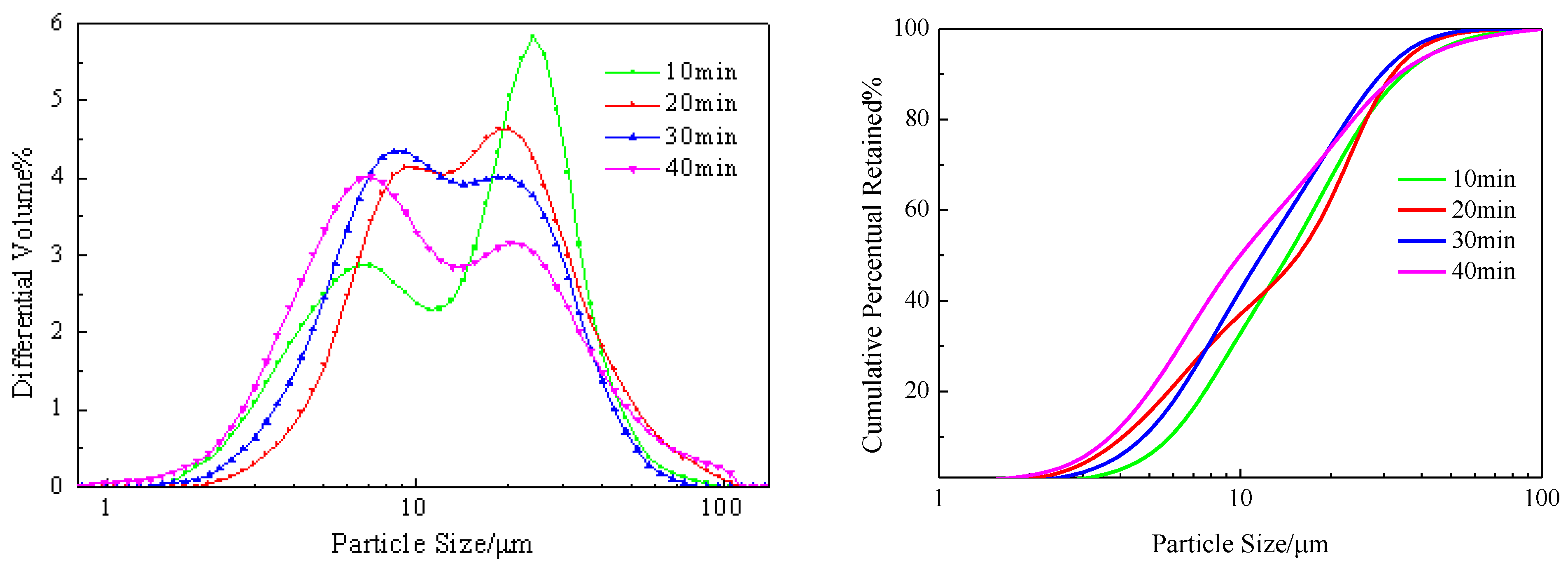
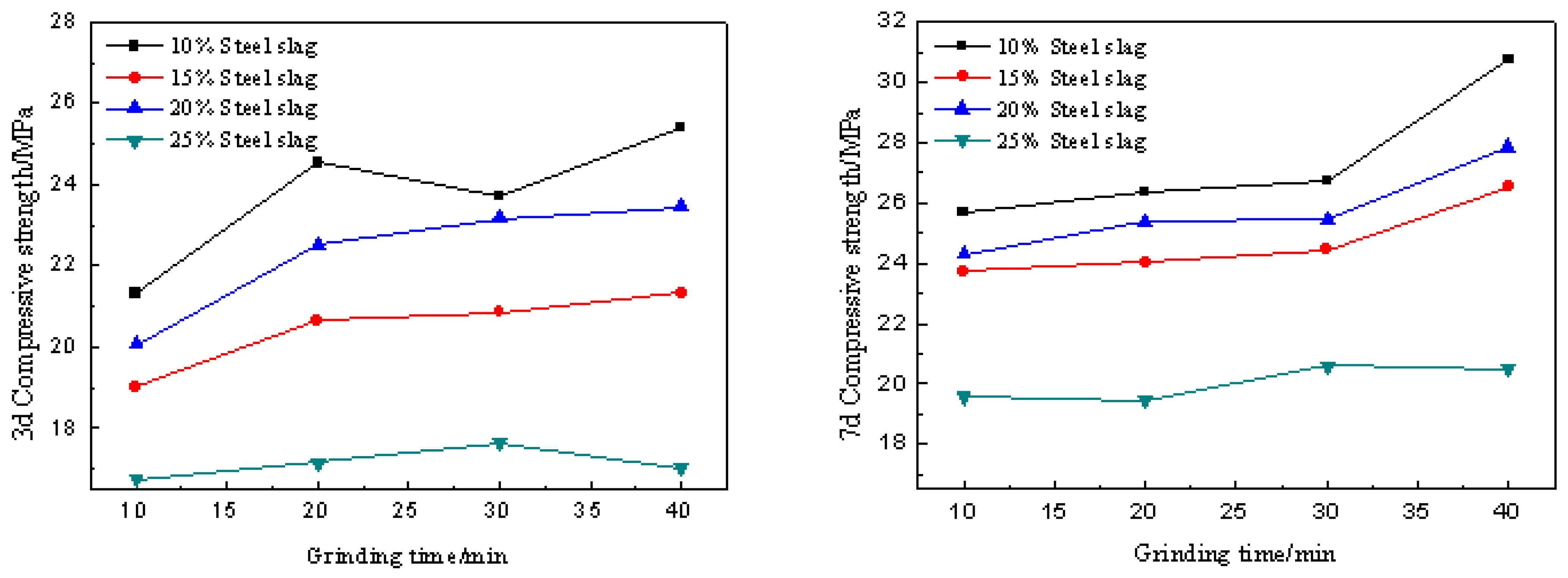

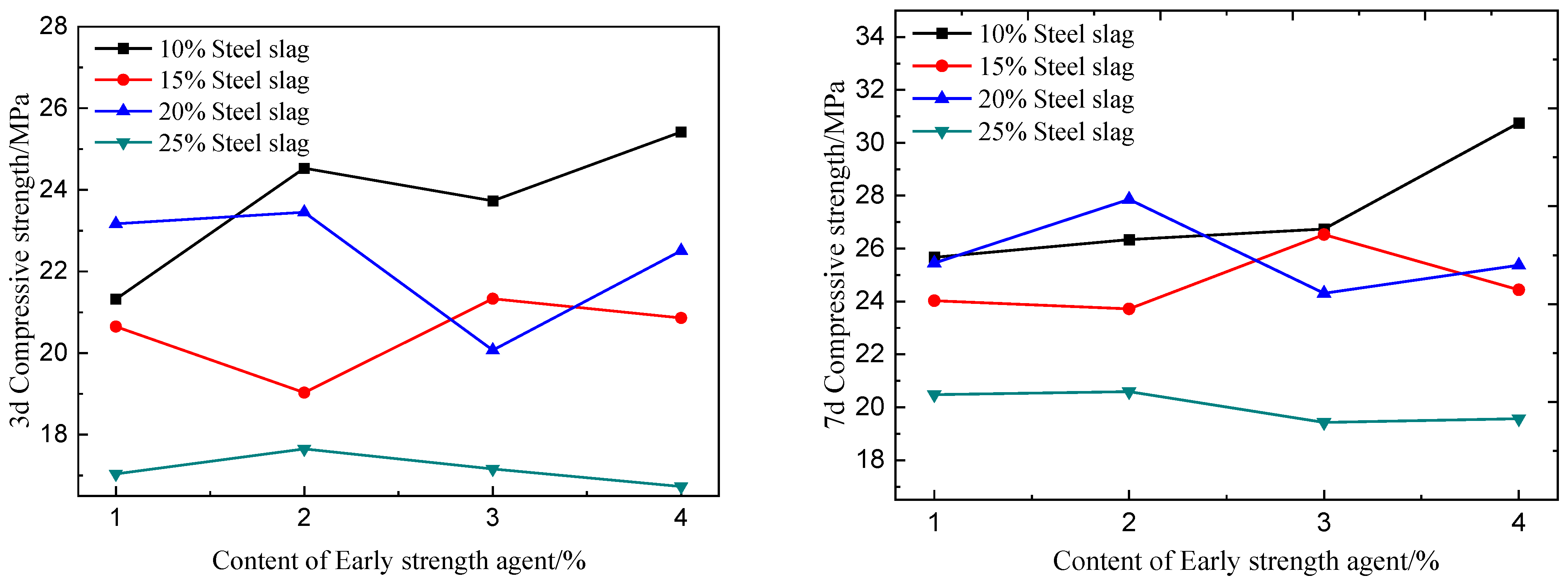


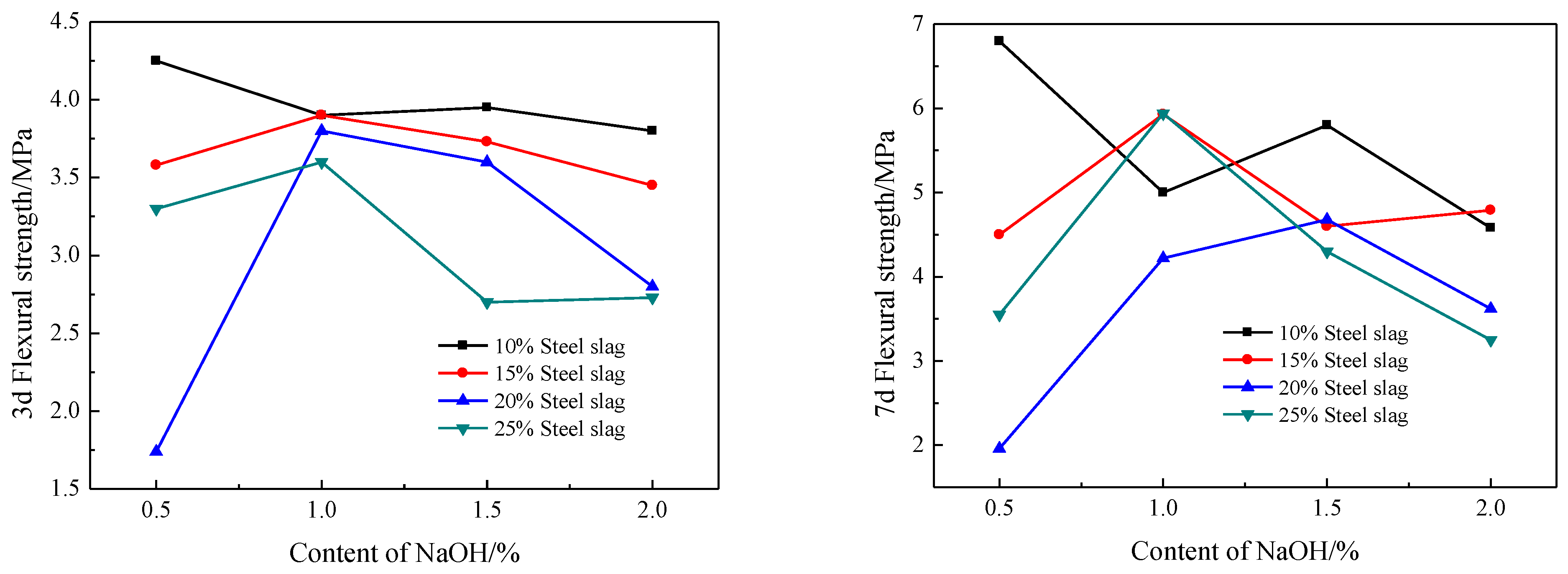
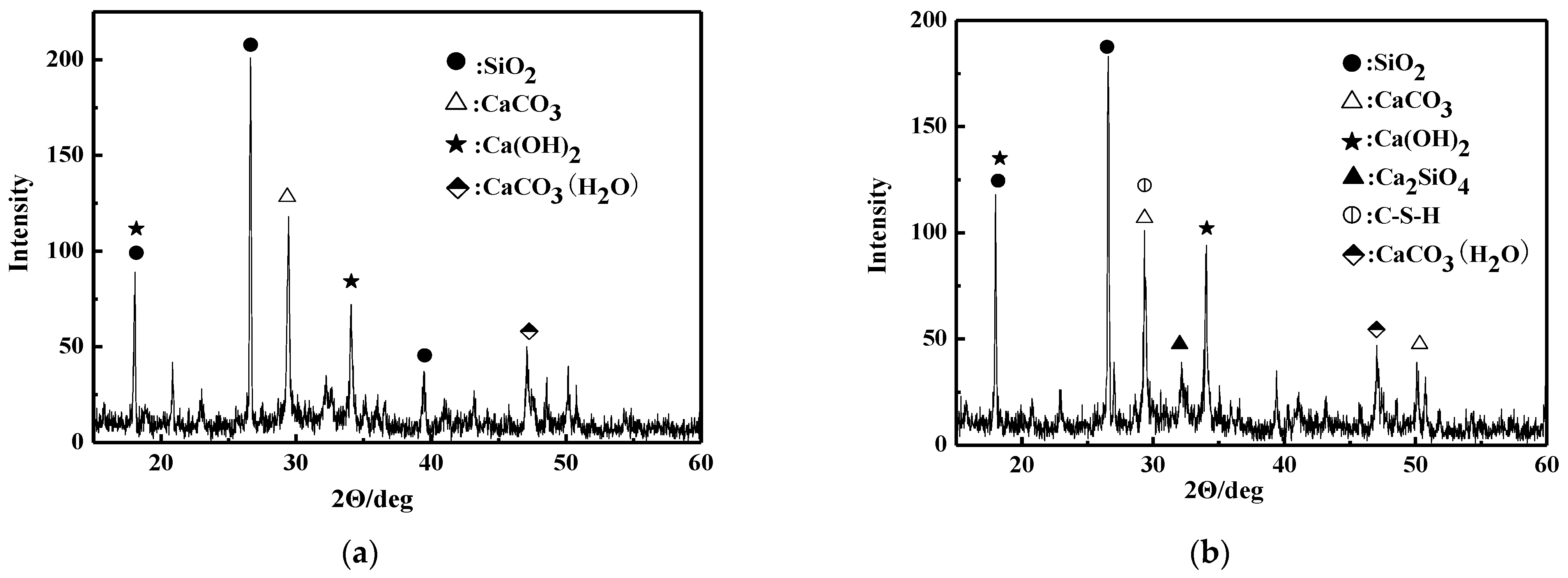

| Raw Material | SiO2/% | Al2O3/% | CaO/% | MgO/% | Fe/% |
|---|---|---|---|---|---|
| Steel slag | 19.92 | 4.08 | 40.83 | 12.48 | 16.69 |
| Steel Slag | Alkalinity Coefficient |
|---|---|
| high basicity slag | R < 1.8 |
| medium basicity slag | 1.8 < R < 2.5 |
| low basicity slag | R > 2.5 |
| Grinding Time | D10/μm | D30/μm | D50/μm | D60/μm | D90/μm |
|---|---|---|---|---|---|
| 10 min | 5.86 | 9.43 | 15.39 | 19.48 | 34.83 |
| 20 min | 4.78 | 7.86 | 14.56 | 17.18 | 31.97 |
| 30 min | 4.08 | 7.80 | 11.76 | 14.65 | 29.36 |
| 40 min | 3.71 | 6.29 | 9.99 | 13.38 | 28.54 |
Disclaimer/Publisher’s Note: The statements, opinions and data contained in all publications are solely those of the individual author(s) and contributor(s) and not of MDPI and/or the editor(s). MDPI and/or the editor(s) disclaim responsibility for any injury to people or property resulting from any ideas, methods, instructions or products referred to in the content. |
© 2023 by the authors. Licensee MDPI, Basel, Switzerland. This article is an open access article distributed under the terms and conditions of the Creative Commons Attribution (CC BY) license (https://creativecommons.org/licenses/by/4.0/).
Share and Cite
Li, M.; Lu, Y.; Yang, S.; Chu, J.; Liu, Y. Study on the Early Effect of Excitation Method on the Alkaline Steel Slag. Sustainability 2023, 15, 4714. https://doi.org/10.3390/su15064714
Li M, Lu Y, Yang S, Chu J, Liu Y. Study on the Early Effect of Excitation Method on the Alkaline Steel Slag. Sustainability. 2023; 15(6):4714. https://doi.org/10.3390/su15064714
Chicago/Turabian StyleLi, Maohui, Youjun Lu, Shaolin Yang, Jingjun Chu, and Yajuan Liu. 2023. "Study on the Early Effect of Excitation Method on the Alkaline Steel Slag" Sustainability 15, no. 6: 4714. https://doi.org/10.3390/su15064714





